NCERT Solutions for Class 9 Maths Chapter 1 - Number System (Exercise 1.3, 1.4 and 1.6)
Exercise 1.3
(i) 36/100
Ans:
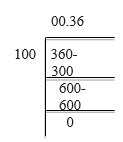
= 0.36 (Terminating)
(ii) 1/11
Ans:
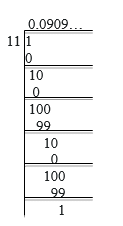

(iii) 
Ans:

= 4.125 (Terminating)
(iv) 3/13
Ans: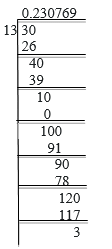

(v) 2/11
Ans: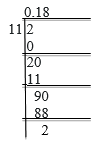

(vi) 329/400
Ans: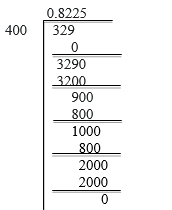
= 0.8225 (Terminating)
Q2. You know that 1/7 =  . Can you predict what the decimal expansions of 2/7, 3/7, 4/7, 5/7, and 6/7 are, without actually doing the long division? If so, how?
. Can you predict what the decimal expansions of 2/7, 3/7, 4/7, 5/7, and 6/7 are, without actually doing the long division? If so, how?
[Hint: Study the remainders while finding the value of 1/7 carefully.]
Ans: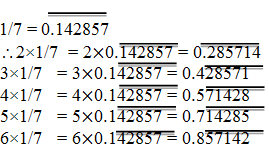
Q3. Express the following in the form p/q, where p and q are integers and q ≠ 0.
(i) 
Ans:
Assume that x = 0.666…
Then,10x = 6.666…
10x = 6 + x
9x = 6
x = 2/3
(ii)
Ans:
= (4/10) + (0.777/10)
Assume that x = 0.777…
Then, 10x = 7.777…
10x = 7 + x
x = 7/9
(4/10) + (0.777../10) = (4/10) + (7/90) ( x = 7/9 and x = 0.777…0.777…/10 = 7/(9 × 10) = 7/90)
= (36/90) + (7/90) = 43/90
(iii) 
Ans:
Assume that x = 0.001001…
Then, 1000x = 1.001001…
1000x = 1 + x
999x = 1
x = 1/999
Q4. Express 0.99999…. in the form p/q . Are you surprised by your answer? With your teacher and classmates discuss why the answer makes sense.
Ans: Assume that x = 0.9999…..Eq (a)
Multiplying both sides by 10,
10x = 9.9999…. Eq. (b)
Eq.(b) – Eq.(a), we get
(10x = 9.9999)-(x = 0.9999…)
9x = 9
x = 1
The difference between 1 and 0.999999 is 0.000001 which is negligible.
Hence, we can conclude that, 0.999 is very close to 1, therefore, 1 as the answer can be justified.
Q5. What can the maximum number of digits be in the repeating block of digits in the decimal expansion of 1/17? Perform the division to check your answer.
Ans: 1/17
Dividing 1 by 17:

There are 16 digits in the repeating block of the decimal expansion of 1/17.
Q6. Look at several examples of rational numbers in the form p/q (q ≠ 0), where p and q are integers with no common factors other than 1 and having terminating decimal representations (expansions). Can you guess what property q must satisfy?
Ans: We observe that when q is 2, 4, 5, 8, 10… Then the decimal expansion is a terminating one.
For example:
1/2 = 0. 5, denominator q = 21
7/8 = 0. 875, denominator q =23
4/5 = 0. 8, denominator q = 51
We can observe that the terminating decimal may be obtained in the situation where prime factorization of the denominator of the given fractions has the power of only 2 or only 5 or both.
Q7. Write three numbers whose decimal expansions are non-terminating and non-recurring.
Ans: We know that all irrational numbers are non-terminating non-recurring. three numbers with decimal expansions that are non-terminating and non-recurring are:
- √3 = 1.732050807568
- √26 =5.099019513592
- √101 = 10.04987562112
Q8. Find three different irrational numbers between the rational numbers 5/7 and 9/11.
Ans:
Three different irrational numbers are:
- 0.73073007300073000073…
- 0.75075007300075000075…
- 0.76076007600076000076…
Q9. Classify the following numbers as rational or irrational according to their type:
(i)√23
Ans: √23 = 4.79583152331…
Since the number is non-terminating and non-recurring, therefore, it is an irrational number.
(ii)√225
Ans: √225 = 15 = 15/1
Since the number can be represented in p/q form, it is a rational number.
(iii) 0.3796
Ans: Since the number, 0.3796, is terminating, it is a rational number.
(iv) 7.478478
Ans: The number, 7.478478, is non-terminating but recurring, it is a rational number.
(v) 1.101001000100001…
Ans: Since the number, 1.101001000100001…, is non-terminating non-repeating (non-recurring), it is an irrational number.
Exercise 1.4
Q1. Classify the following numbers as rational or irrational:
(i) 2 –√5
Ans: We know that, √5 = 2.2360679…
Here, 2.2360679…is non-terminating and non-recurring.
Now, substituting the value of √5 in 2 –√5, we get,
2-√5 = 2-2.2360679… = -0.2360679
Since the number, – 0.2360679…, is non-terminating non-recurring, 2 –√5 is an irrational number.
(ii) (3 +√23)- √23
Ans: (3 +√23) –√23 = 3+√23–√23
= 3
= 3/1
Since the number 3/1 is in p/q form, (3 +√23)- √23 is rational.
(iii) 2√7/7√7
Ans: 2√7/7√7 = ( 2/7) × (√7/√7)
We know that (√7/√7) = 1
Hence, ( 2/7) × (√7/√7) = (2/7) × 1 = 2/7
Since the number, 2/7 is in p/q form, 2√7/7√7 is rational.
(iv) 1/√2
Ans: Multiplying and dividing the numerator and denominator by √2 we get,
(1/√2) × (√2/√2)= √2/2 ( since √2 × √2 = 2)
We know that, √2 = 1.4142…
Then, √2/2 = 1.4142/2 = 0.7071..
Since the number 0.7071..is non-terminating and non-recurring, 1/√2 is an irrational number.
(v) 2π
Ans: We know that, the value of π = 3.1415
Hence, 2 = 2 × 3.1415.. = 6.2830…
Since the number, 6.2830…, is non-terminating and non-recurring, 2π is an irrational number.
Q2. Simplify each of the following expressions:
(i) (3 + √3) (2 + √2)
Ans: (3 + √3) (2 + √2 )
Opening the brackets, we get, (3 × 2) + (3 × √2) + (√3 × 2) + (√3 × √2)
= 6 + 3√2 + 2√3 + √6
(ii) (3 + √3) (3 - √3)
Ans: (3 + √3) (3 - √3 ) = 32 - (√3)2 = 9 - 3
= 6
(iii) (√5 + √2)2
Ans: (√5 + √2)2 = √52 + (2 × √5 × √2) + √22
= 5 + 2 × √10 + 2 = 7 + 2√10
(iv) (√5 - √2)(√5 + √2)
Ans: (√5 - √2)(√5 + √2) = (√52 - √22) = 5 - 2 = 3
Q3. Recall, π is defined as the ratio of the circumference (say c) of a circle to its diameter, (say d). That is, π = c/d. This seems to contradict the fact that π is irrational. How will you resolve this contradiction?
Ans: There is no contradiction.
When we measure a value with a scale, we only obtain an approximate value.
We never obtain an exact value.
Therefore, we may not realize whether c or d is irrational.
The value of π is almost equal to 22/7 or 3.142857…
Q4. Represent (√9.3) on the number line.
Ans:
Step 1: Draw a 9.3-unit long line segment, AB. Extend AB to C such that BC = 1 unit.
Step 2: Now, AC = 10.3 units. Let the centre of AC be O.
Step 3: Draw a semi-circle of radius OC with centre O.
Step 4: Draw a BD perpendicular to AC at point B intersecting the semicircle at D. Join OD.
Step 5: OBD, obtained, is a right-angled triangle.
Here, OD 10.3/2 (radius of semi-circle), OC = 10.3/2 , BC = 1
OB = OC – BC
⟹ (10.3/2)-1 = 8.3/2
Using Pythagoras theorem,
We get,
OD2 = BD2 + OB2
⟹ (10.3/2)2 = BD2+(8.3/2)2
⟹ BD2 = (10.3/2)2-(8.3/2)2
⟹ (BD)2 = (10.3/2)-(8.3/2)(10.3/2)+(8.3/2)
⟹ BD2 = 9.3
⟹ BD = √9.3
Thus, the length of BD is √9.3.
Step 6: Taking BD as the radius and B as the centre draw an arc which touches the line segment.
The point where it touches the line segment is at a distance of √9.3 from O as shown in the figure.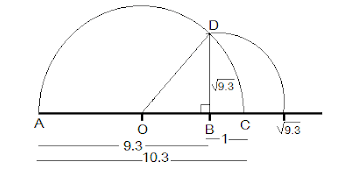
Q5. Rationalize the denominators of the following:
(i) 1/√7
Ans: Multiply and divide 1/√7 by √7
(1×√7)/(√7×√7) = √7/7
(ii) 1/(√7-√6)
Ans: Multiply and divide 1/(√7 - √6) by (√7 + √6)
[1/(√7 - √6)] × (√7 + √6)/(√7 + √6) = (√7 + √6)/(√7 - √6)(√7 + √6)
= (√7 + √6)/√72 - √62 [denominator is obtained by the property, (a + b)(a - b) = a2 - b2]
= (√7 + √6)/(7 - 6)
= (√7 + √6)/1
= √7 + √6
(iii) 1/(√5+√2)
Ans: Multiply and divide 1/(√5 + √2) by (√5 - √2)
[1/(√5 + √2)] × (√5 - √2)/(√5 - √2) = (√5 - √2)/(√5 + √2)(√5 - √2)
= (√5 - √2)/(√52 - √22) [denominator is obtained by the property, (a + b)(a - b) = a2 - b2]
= (√5 - √2)/(5 - 2)
= (√5 - √2)/3
(iv) 1/(√7-2)
Ans: Multiply and divide 1/(√7 - 2) by (√7 + 2)
1/(√7 - 2) × (√7 + 2)/(√7 + 2) = (√7 + 2)/(√7 - 2)(√7 + 2)
= (√7 + 2)/(√72 - 22) [denominator is obtained by the property, (a + b)(a - b) = a2-b2]
= (√7 + 2)/(7 - 4)
= (√7 + 2)/3
Exercise 1.5
Q1. Find:
(i) 641/2
Ans: 641/2 = (8 × 8)1/2
= (82)½
= 81 [⸪2 × 1/2 = 2/2 = 1]
= 8
(ii) 321/5
Ans: 321/5 = (25)1/5
= (25)⅕
= 21 [⸪ 5 × 1/5 = 1]
= 2
(iii) 1251/3
Ans: (125)1/3 = (5 × 5 × 5)1/3
= (53)⅓
= 51 (3 × 1/3 = 3/3 = 1)
= 5
Q2. Find:
(i) 93/2
Ans: 93/2 = (3 × 3)3/2
= (32)3/2
= 33 [⸪ 2 × 3/2 = 3]
=27
(ii) 322/5
Ans: 322/5 = (2 × 2 × 2 × 2 × 2)2/5
= (25)2⁄5
= 22 [⸪ 5 × 2/5= 2]
= 4
(iii)163/4
Ans: 163/4 = (2 × 2 × 2 × 2)3/4
= (24)3⁄4
= 23 [⸪ 4 × 3/4 = 3]
= 8
(iv) 125-1/3
Ans: 125-1/3 = (5 × 5 × 5)-1/3
= (53)-1⁄3
= 5-1 [⸪ 3 × -1/3 = -1]
= 1/5
Q.3. Simplify:
(i) 22/3×21/5
Ans: 22/3 × 21/5 = 2(2/3)+(1/5) [⸪Since, am × an= am+n____ Laws of exponents]
= 213/15 [⸪ 2/3 + 1/5 = (2 × 5 + 3 × 1)/(3 × 5) = 13/15]
(ii) (1/33)7
Ans: (1/33)7 = (3-3)7 [⸪Since,(am)n = am x n____ Laws of exponents]
= 3-21
(iii) 111/2/111/4
Ans: 111/2/111/4 = 11(1/2)-(1/4)
= 111/4 [⸪(1/2) – (1/4) = (1×4-2×1)/(2×4) = 4-2)/8 = 2/8 = ¼ ]
(iv) 71/2× 81/2
Ans: 71/2× 81/2 = (7 × 8)1/2 [⸪ Since, (am × bm = (a × b)m ____ Laws of exponents]
= 561/2
|
40 videos|560 docs|57 tests
|
FAQs on NCERT Solutions for Class 9 Maths Chapter 1 - Number System (Exercise 1.3, 1.4 and 1.6)
| 1. What are the key concepts covered in NCERT Number System Exercise 1.3, 1.4, and 1.6? |  |
| 2. How do I represent irrational numbers on a number line as per NCERT guidelines? |  |
| 3. What strategies can I use to solve problems in Exercise 1.4 related to operations on rational numbers? |  |
| 4. Are there any specific properties of rational and irrational numbers that I should memorize for my exam? |  |
| 5. How can I effectively prepare for questions related to the number system in my exams? |  |

















